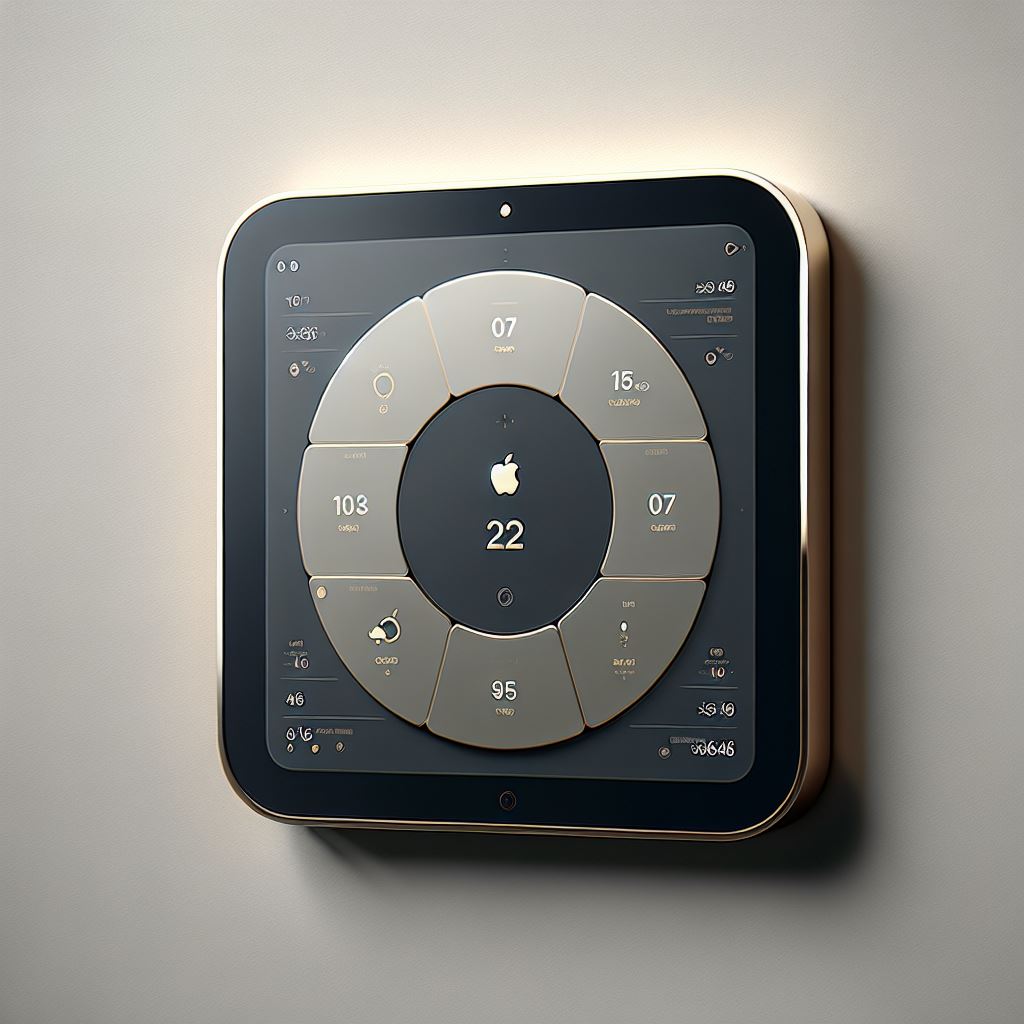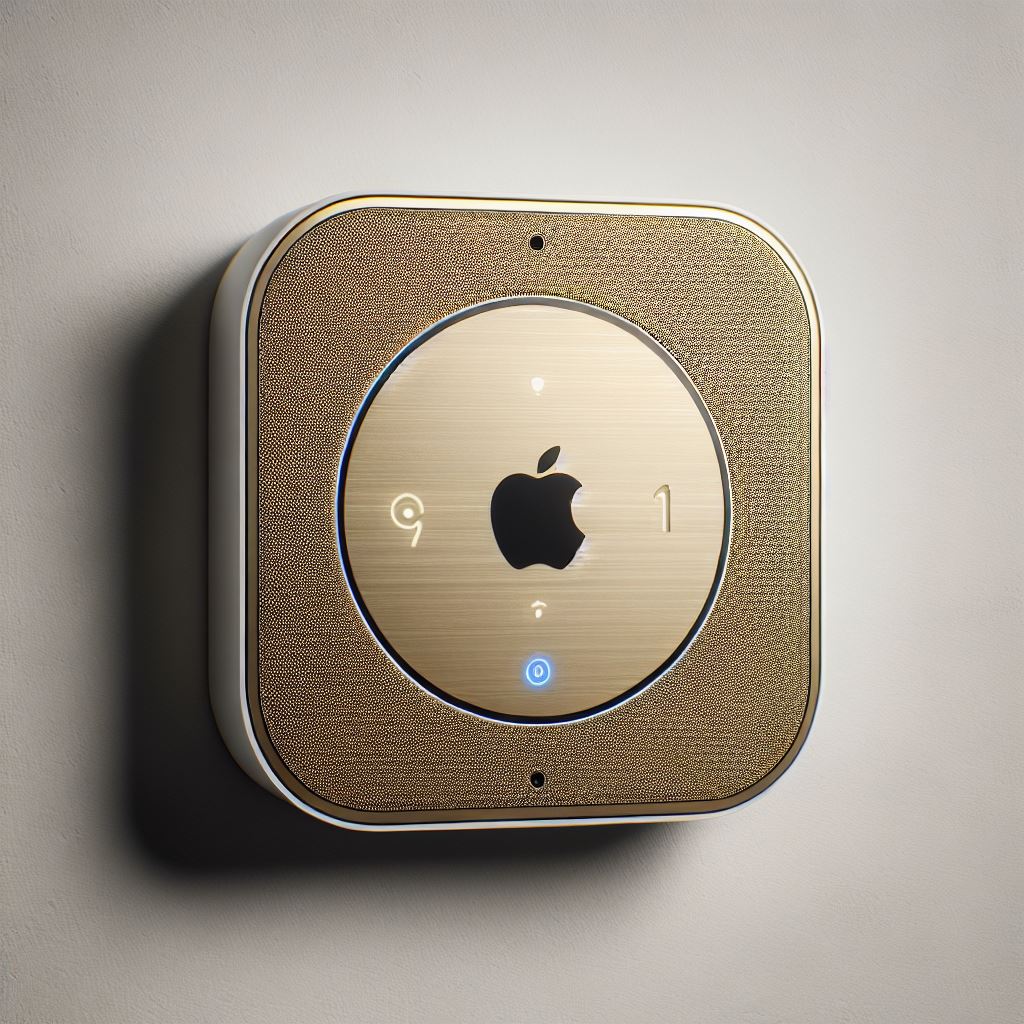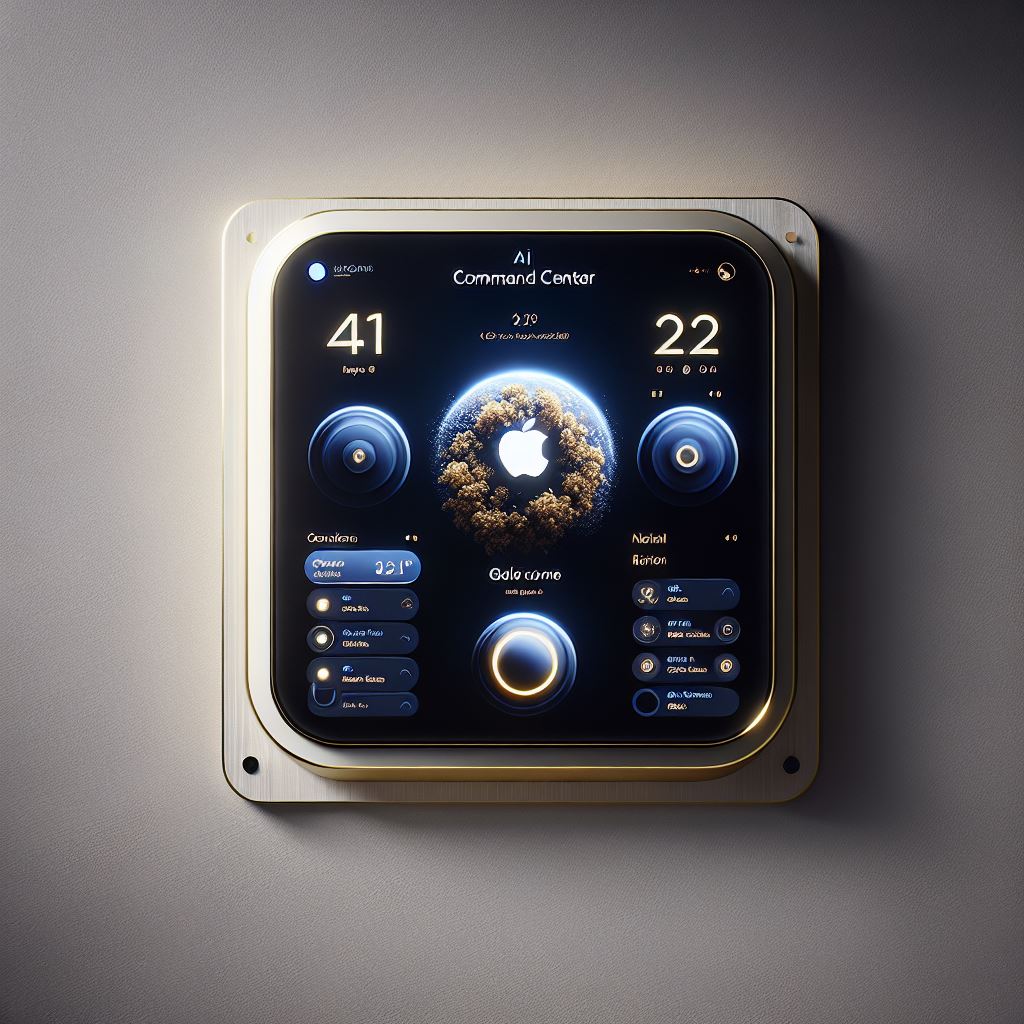Apple’s AI Smart Home Command Center
The Apple AI Smart Home Command Center is generating significant buzz due to its integration of advanced AI capabilities (see below) and seamless smart home control. Expected to launch in March 2025, this device aims to revolutionize how users interact with their smart homes.
DESIGN and Placement: The Apple AI Smart Home Command Center is expected to have a display measuring approximately six inches. The device is designed to be square rather than rectangular, with thick bezels around the edges. This compact size makes it suitable for wall mounting and easy integration into various home environments.
Device Control & Compatibility: Designed to be most compatible with Apple’s ecosystem: integration of iPhones, iPads, and Apple Watches (Siri Integration, Handoff Feature, iCloud Sync and FaceTime and Messaging) and ALSO including HomeKit-enabled devices (see below).
Network Connectivity: The device will connect via Wi-Fi 6 (802.11ax) and Bluetooth 5.2, ensuring robust and reliable communication with other smart home devices.
- Smart Home Control: It allows you to control HomeKit-compatible devices such as lights, thermostats, locks, cameras, and more, all from a single interface.
- Voice Commands: The device integrates with Siri, enabling you to use voice commands to manage your smart home. This makes it easy to control devices hands-free.
- FaceTime and Communication: Equipped with a built-in camera, the Command Center supports FaceTime calls, making it a convenient communication tool for your home.
- Customizable Interface: The display features a customizable home screen with widgets for weather, appointments, photo slideshows, and important home controls. It adapts based on your proximity, showing relevant information as you approach.
- Security Features: It provides alerts and camera footage from connected smart home cameras, enhancing your home security.
- Integration with Apple Apps: The Command Center includes several Apple apps like Safari, Apple News, Apple Music, Notes, Calendar, and Photos, though it does not have a dedicated App Store.
- Intercom Functionality: Multiple Command Centers in different rooms can work as intercoms, allowing for easy communication throughout your home.
- Touch and Voice Control: While the device has a touch-based interface, it is primarily controlled by voice through Siri and Apple Intelligence.
Approximate Cost: The expected price range is between $180 and $230, positioning it competitively against similar products from Amazon and Google.
Reasons Why
- Seamless Integration: Works flawlessly with Apple’s ecosystem.
- Advanced AI: Utilizes Apple Intelligence for smart home automation.
- Voice Control: Operated primarily through Siri, offering hands-free convenience.
- User-Friendly Interface: Intuitive touch and voice-based controls.
- Security: Enhanced security features with real-time alerts.
- Customizable: Widgets and home screen customization.
- Intercom Functionality: Acts as an intercom system within the home.
- FaceTime Capability: Built-in camera for video calls.
- Energy Efficiency: Smart energy management features.
- Future-Proof: Regular updates and potential for new features.
Reasons Why Not
- Apple Ecosystem Dependency: Best performance within Apple’s ecosystem, limiting compatibility with non-Apple devices.
- Limited App Store: No dedicated App Store, limiting app availability.
- Learning Curve: May require time to learn and fully utilize all features.
- Potential Over-Reliance on AI: Heavy reliance on AI might not appeal to all users.

AI FEATURE Details:
Here are some of examples of how the AI in the Apple AI Smart Home Command Center can enhance your smart home experience:
- Predictive Automation: The AI can learn your daily routines and preferences over time. For instance, if you usually dim the lights and lower the thermostat in the evening, the Command Center will start doing this automatically as it gets to know your habits. This predictive automation helps create a more comfortable and personalized living environment without you having to manually adjust settings.
- Contextual Responses: The AI can provide contextual responses based on your location and activity. For example, if you ask Siri to “turn off the lights,” the Command Center will know which room you are in and only turn off the lights in that specific room. Additionally, if you receive a video call while cooking, the AI can suggest switching the call to a nearby HomePod or another device for better convenience.
- Energy Management: The AI can optimize energy usage by learning your habits and adjusting devices accordingly. For example, it can turn off lights and appliances when they are not in use or when you leave the house, helping to reduce energy consumption and lower utility bills.
- Security Enhancements: The AI can monitor security cameras and sensors, recognizing unusual activity and sending alerts to your devices. It can also simulate occupancy by turning lights on and off when you’re away, deterring potential intruders.
- Health Monitoring: If integrated with health devices, the AI can track your health metrics and suggest adjustments to your environment. For instance, it can adjust the air purifier settings if it detects poor air quality or remind you to take a break if you’ve been sitting for too long.
- Voice Recognition: The AI can distinguish between different household members’ voices, providing personalized responses and actions. For example, it can greet each family member by name and adjust settings based on their preferences.
- Routine Suggestions: Based on your daily activities, the AI can suggest new routines or automations to improve your lifestyle. For instance, it might recommend a morning routine that includes gradually increasing the light brightness, playing your favorite music, and starting the coffee maker.
- Context-Aware Notifications: The AI can provide notifications based on your current context. For example, if it detects that you’re watching a movie, it might suggest enabling “Do Not Disturb” mode to prevent interruptions.

HomeKit-enabled devices
HomeKit-enabled devices are designed to work seamlessly with Apple’s HomeKit platform, allowing users to control them through the Home app on their iPhone, iPad, or Mac, as well as via Siri voice commands. Here are some categories and examples of HomeKit-enabled devices:
- Smart Doorbells: See and communicate with visitors using doorbells from Netatmo and Logitech.
- Apple Face ID Video Doorbell: Uses Face ID technology for secure access and integrates with HomeKit for remote control and monitoring. – NEW ADDITION
- Netatmo Smart Video Doorbell: Offers HD video, two-way communication, and facial recognition.
- Smart Lights: Control your lighting with brands like Philips Hue, LIFX, and Nanoleaf.
- Philips Hue: Offers a wide range of smart bulbs, light strips, and fixtures that can be controlled via the Home app.
- LIFX: Provides smart bulbs with vibrant colors and easy integration with HomeKit.
- Smart Thermostats: Efficiently manage your home’s temperature with devices from ecobee and Honeywell.
- ecobee SmartThermostat: Features voice control, room sensors, and energy-saving capabilities.
- Honeywell Home T9: Includes smart room sensors and customizable comfort settings.
- Smart Locks: Enhance your home security with smart locks from August, Schlage, and Yale.
- August Smart Lock Pro: Allows you to lock and unlock your door remotely and integrates seamlessly with HomeKit.
- Schlage Encode: Offers keyless entry and remote access through the Home app.
- Smart Cameras: Monitor your home with cameras from Logitech Circle, Arlo, and Eufy.
- Logitech Circle View: Provides high-definition video, night vision, and secure storage options.
- Arlo Ultra: Features 4K video quality, color night vision, and advanced motion detection.
- Smart Plugs: Automate your appliances with smart plugs from Eve, Wemo, and Meross.
- Eve Energy: Monitors power consumption and allows remote control of connected devices.
- Wemo Mini Smart Plug: Compact design that fits into any outlet and supports voice control.
- Smart Sensors: Detect motion, temperature, and humidity with sensors from Aqara and Fibaro.
- Aqara Motion Sensor: Detects motion and triggers automations in the Home app.
- Fibaro Flood Sensor: Alerts you to water leaks and temperature changes.
- Smart Sprinkler Systems: Manage your garden with systems from Rachio and Eve.
- Rachio 3: Provides weather-based watering schedules and remote control.
- Eve Aqua: Automates your garden watering and integrates with HomeKit.
- Smart Speakers: Control your home with voice commands using Apple HomePod and HomePod mini.
- Apple HomePod: Delivers high-fidelity audio and serves as a HomeKit hub.
- Apple HomePod mini: Compact smart speaker with Siri integration and HomeKit support.
- Smart TVs: Integrate your entertainment with TVs from LG, Sony, and Vizio.
- LG OLED TV: Supports HomeKit and AirPlay 2 for seamless integration with your Apple devices.
- Sony Bravia: Offers HomeKit compatibility and advanced picture quality.
These devices can be controlled individually or set up to work together in scenes and automations, making your home smarter and more convenient.

Enhanced security features
- End-to-End Encryption: All communications between the Command Center and connected devices are encrypted, ensuring that data is secure and cannot be intercepted by unauthorized parties.
- Secure Video: For devices like security cameras, video streams are encrypted and can only be accessed by authorized users. This prevents unauthorized viewing of your camera feeds.
- Two-Factor Authentication (2FA): To access the Command Center and make changes to your smart home setup, users can enable two-factor authentication, adding an extra layer of security.
- Biometric Authentication: The Command Center supports biometric authentication methods such as Face ID and Touch ID, ensuring that only authorized users can access and control the device.
- Real-Time Alerts: The system can send real-time alerts to your iPhone, iPad, or Apple Watch if it detects unusual activity, such as unexpected motion or attempts to access the system.
- Privacy Controls: Users have granular control over what data is shared and with whom. You can manage permissions for each connected device and ensure that your personal information remains private.
- Automatic Updates: The Command Center receives regular software updates from Apple, which include security patches and new features to keep your system secure and up-to-date.
- HomeKit Secure Video: For HomeKit-enabled cameras, video recordings are stored securely in iCloud with end-to-end encryption, and only you and those you share access with can view the recordings.

Competitor Comparisons
- Amazon Echo Hub: The Echo Hub is a strong competitor, offering similar smart home control features. It integrates well with Amazon’s Alexa and supports a wide range of smart home devices. However, it lacks the deep integration with Apple’s ecosystem that the Command Center offers. The Echo Hub is priced lower, making it a more budget-friendly option.
- Google Nest Hub Max: Google’s Nest Hub Max is another formidable competitor. It features a larger display and integrates seamlessly with Google Assistant. The Nest Hub Max excels in video calling and smart home control but doesn’t offer the same level of customization and security features as Apple’s Command Center. Its price is comparable to Apple’s offering.
- Samsung SmartThings Hub: Samsung’s SmartThings Hub is known for its extensive compatibility with a wide range of smart home devices. It supports multiple protocols, including Zigbee and Z-Wave, making it a versatile choice. However, it lacks the advanced AI capabilities and seamless integration with Apple’s ecosystem that the Command Center provides. The SmartThings Hub is also priced competitively.



